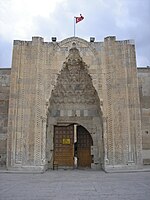Related Research Articles

Malik-Shah I, was the third sultan of the Seljuk Empire from 1072 to 1092, under whom the sultanate reached its zenith of power and influence.
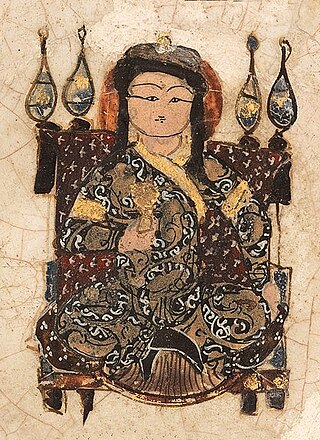
Abu Talib Muhammad Tughril ibn Mika'il, better known as Tughril, was a Turkoman chieftain, who founded the Seljuk Empire, ruling from 1037 to 1063.

The Sultanate of Rûm was a culturally Turco-Persian Sunni Muslim state, established over conquered Byzantine territories and peoples (Rûm) of Anatolia by the Seljuk Turks following their entry into Anatolia after the Battle of Manzikert (1071). The name Rûm was a synonym for the medieval Eastern Roman Empire and its peoples, as it remains in modern Turkish. The name is derived from the Aramaic (rhπmÈ) and Parthian (frwm) names for ancient Rome, via the Greek Ῥωμαῖοι (Romaioi).

The Qajar dynasty was an Iranian dynasty founded by Mohammad Khan of the Qoyunlu clan of the Turkoman Qajar tribe.

Abu Shuja Ghiyath al-Dunya wa'l-Din Muhammad ibn Malik-Shah, better known as Muhammad I Tapar, was the sultan of the Seljuk Empire from 1105 to 1118. He was a son of Malik-Shah I and Taj al-Din Khatun Safariya. In Turkish, Tapar means "he who obtains, finds".

Mughith al-Dunya wa'l-Din Mahmud bin Muhammad known as Mahmud II was the Seljuk sultan of Iraq from 1118–1131 following the death of his father Muhammad I Tapar. At the time Mahmud was fourteen, and ruled over Iraq and Persia.

Abū ʾl-Qāsim al-Faḍl ibn al-Muqtadir, better known by his regnal name of al-Mutīʿ li-ʾllāh, was the Abbasid caliph in Baghdad from 946 to 974, ruling under the tutelage of the Buyid emirs.

Abū Ja'far Abdallah ibn Aḥmad al-Qādir, better known by his regnal name al-Qā'im bi-amri 'llāh or simply as al-Qā'im; 8 November 1001 – 3 April 1075), was the Abbasid caliph in Baghdad from 1031 to 1075. He was the son of the previous caliph, al-Qadir. Al-Qa'im's reign coincided with the end of the Buyid dynasty's dominance of the caliphate and the rise of the Seljuk dynasty.

The Battle of Basiani was fought between the armies of the Kingdom of Georgia and the Seljuqid Sultanate of Rum in the Basiani Valley, 60 km north-east of the city of Erzurum in what is now northeast Republic of Turkey. The date of the battle has been debated, but recent scholarship tends to favor the years 1203 or 1204. According to the contemporary Muslim chronicler Ibn Bibi, the battle took place in 598 AH. According to modern Turkish historians, the site of the battle is usually identified as the castle of Micingerd (Mazankert).

The Seljuk dynasty, or Seljukids, Seljuqs, also known as Seljuk Turks, Seljuk Turkomans or the Saljuqids, was an Oghuz Turkic, Sunni Muslim dynasty that gradually became Persianate and contributed to Turco-Persian culture in West Asia and Central Asia. The Seljuks established the Seljuk Empire (1037–1194), the Sultanate of Kermân (1041–1186) and the Sultanate of Rum (1074–1308), which stretched from Iran to Anatolia and were the prime targets of the First Crusade.
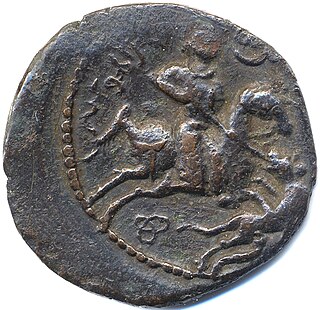
Alā ad-Dīn Kayqubād ibn Kaykhusraw, also known as Kayqubad I, was the Seljuq Sultan of Rûm who reigned from 1220 to 1237. He expanded the borders of the sultanate at the expense of his neighbors, particularly the Mengujek Beylik and the Ayyubids, and established a Seljuq presence on the Mediterranean with his acquisition of the port of Kalon Oros, later renamed Ala'iyya in his honor. The sultan, sometimes styled Kayqubad the Great, is remembered today for his rich architectural legacy and the brilliant court culture that flourished under his reign.

Ghiyath al-Din Kaykhusrawibn Kayqubād or Kaykhusraw II was the sultan of the Seljuqs of Rûm from 1237 until his death in 1246. He ruled at the time of the Babai uprising and the Mongol invasion of Anatolia. He led the Seljuq army with its Christian allies at the Battle of Köse Dağ in 1243. He was the last of the Seljuq sultans to wield any significant power and died as a vassal of the Mongols.
Kaykaus I or Izz ud-DinKaykaus ibn Kaykhusraw was the Sultan of Rum from 1211 until his death in 1220. He was the eldest son of Kaykhusraw I.

Sa’d al-Din Köpek was a court administrator under two 13th century Seljuq Sultans of Rum and is known for his indirect role in the subjugation of the Sultanate of Rum by the Mongol Empire due to his disloyalty and aim for greater power during the turbulent 13th century in Anatolia.
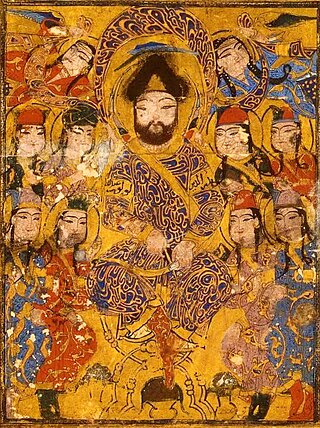
Badr al-Din Lu'lu' was successor to the Zengid emirs of Mosul, where he governed in variety of capacities from 1234 to 1259 following the death of Nasir ad-Din Mahmud. He was the founder of the short-lived Luluid dynasty. Originally a slave of the Zengid ruler Nur al-Din Arslan Shah I, he was the first Middle-Eastern mamluk to transcend servitude and become an emir in his own right, founding the dynasty of the Lu'lu'id emirs (1234-1262), and anticipating the rise of the Bahri Mamluks of the Mamluk Sultanate of Egypt by twenty years. He preserved control of al-Jazira through a series of tactical submissions to larger neighboring powers, at various times recognizing Ayyubid, Rûmi Seljuq, and Mongol overlords. His surrender to the Mongols after 1243 temporarily spared Mosul the destruction experienced by other settlements in Mesopotamia.

Abu Suleiman Dawud Chaghri Beg ibn Mikail, widely known simply as Chaghri Beg (989–1060), Da'ud b. Mika'il b. Saljuq, also spelled Chaghri, was the co-ruler of the early Seljuk Empire. The name Chaghri is Turkic and literally means "small falcon", "merlin".
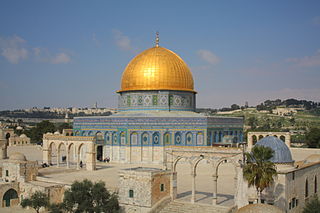
Umayyad architecture developed in the Umayyad Caliphate between 661 and 750, primarily in its heartlands of Syria and Palestine. It drew extensively on the architecture of older Middle Eastern and Mediterranean civilizations including the Sassanian Empire and Byzantine Empire, but introduced innovations in decoration and form. Under Umayyad patronage, Islamic architecture began to mature and acquire traditions of its own, such as the introduction of mihrabs to mosques, a trend towards aniconism in decoration, and a greater sense of scale and monumentality compared to previous Islamic buildings. The most important examples of Umayyad architecture are concentrated in the capital of Damascus and the Greater Syria region, including the Dome of the Rock, the Great Mosque of Damascus, and secular buildings such as the Mshatta Palace and Qusayr 'Amra.
Tamta Zakarian or Tamta Mkhargrdzeli was an Armenian Chalcedonian Christian noble woman of Kurdish descent, born at the court of queen Tamar of Georgia. She appears in only a few written sources, including contemporary histories by Kirakos Gandzaketsi and Vardan Areveltsi.

The Khwarazmian army, also called the Khwarazmiyya, maintained itself as a force of freebooters and mercenaries between 1231 and 1246, following the Mongol conquest of the Khwarazmian Empire (1221) and the death of the last Khwarazmshah, Jalal al-Din (1231). It was active in Upper Mesopotamia, Anatolia, Syria and Palestine and shifted its allegiance several times, often acting autonomously before it was defeated and destroyed by the Ayyubids.

Nasir al-Din Artuq Arslan was a ruler of the Artuqids of Mardin. The "Mardin branch" of the Artuqids ruled in Mardin and Mayyafariqin from 1101 to 1409, and were primarily descendants of Ilghazi and his brother Alp-Yaruq. His predecessor was his father Yuluq Arslan.
References
- ↑ Lambton & Lewis 1977, p. 248.
- 1 2 3 4 5 6 7 Busse 1997, p. 818.
- 1 2 Eastmond 2017, p. 197.
